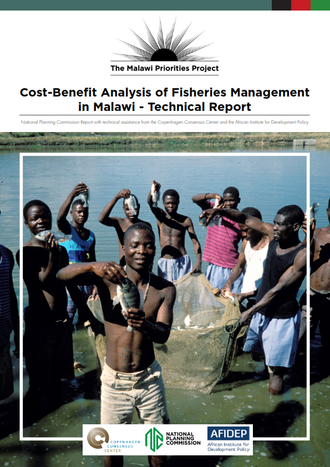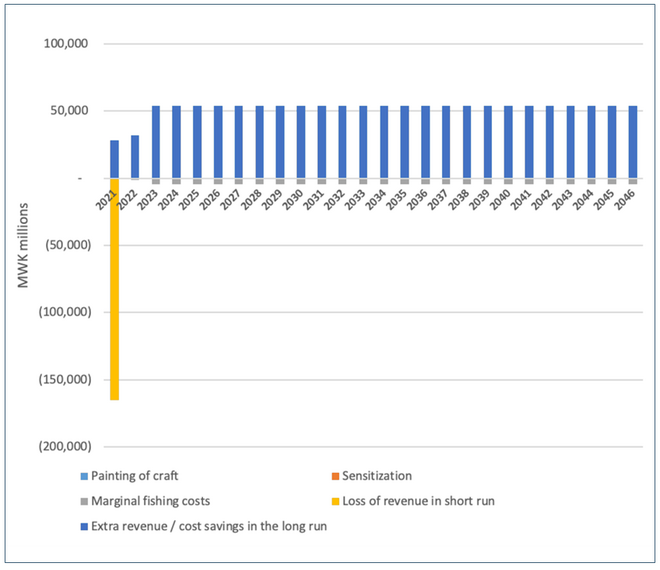Malawi Priorities: Fisheries
Technical Report
Key Messages
 The fisheries sector is very important to Malawi’s economy, livelihoods, food security, and biodiversity. One estimate puts the total contribution of the sector at 7.2% of GDP while employing 700,000 people either directly or indirectly. Unfortunately, there is evidence of extreme overfishing, with 50% more craft than should be the case for maximum sustainable yield. Almost 90% of all nets used are illegal, with mesh sizes that are too small, capturing juvenile and spawning fish that curtail the reproductive capacity of fish species. This paper estimates that in 2018, profit from the fisheries sector was more than 5 times larger than the expected profit at maximum sustainable yield. These unsustainable profits cannot last forever, and will likely come at the expense of an imminent collapse in the fisheries stock if unaddressed, as evidenced by the reduction and possible extinction of the once prolific chambo species in Lake Malawi.
The fisheries sector is very important to Malawi’s economy, livelihoods, food security, and biodiversity. One estimate puts the total contribution of the sector at 7.2% of GDP while employing 700,000 people either directly or indirectly. Unfortunately, there is evidence of extreme overfishing, with 50% more craft than should be the case for maximum sustainable yield. Almost 90% of all nets used are illegal, with mesh sizes that are too small, capturing juvenile and spawning fish that curtail the reproductive capacity of fish species. This paper estimates that in 2018, profit from the fisheries sector was more than 5 times larger than the expected profit at maximum sustainable yield. These unsustainable profits cannot last forever, and will likely come at the expense of an imminent collapse in the fisheries stock if unaddressed, as evidenced by the reduction and possible extinction of the once prolific chambo species in Lake Malawi.- The recommended intervention is to initiate fishing by rotation policy. The upfront costs involve painting the boats to designate which days they are allowed to fish (MWK 0.3 billion), plus foregone revenue in the first year (MWK 164.3 billion). However, this would reduce effective fishing efforts down to 2,475 ‘full-time’ craft (from 18,000 currently) and avoid a drastic reduction in the fisheries stock. In the long run, this would lead to an extra MWK 53.7 billion in sustainable revenue and ongoing fishing costs of MWK 4.4 billion per year. For every kwacha invested the return is 2.8.
- In contrast, replacing the illegal nets does not pass a cost-benefit test. This is because the upfront costs of the intervention are very large – more than MWK 91.1 billion to replace the nets, plus foregone (unsustainable) revenues of MWK 180.1 billion for one year. Importantly, the intervention still leaves 18,000 vessels in the waters of Lake Malawi and surrounding water bodies, striving for the same limited pool of fish. While revenues are MWK 55.4 billion, large operational costs of MWK 32.5 billion are also incurred annually.
Context
The fisheries sector in Malawi comprises two subsectors; (i) capture fisheries, which is the dominant sector, and (ii) the aquaculture sector. For capture fisheries, Lake Malawi is the foremost fishing area, responsible for most of the fish in the region along with Lake Chilwa. The capture fishery in Lake Malawi is highly diverse. It consists of large-scale commercial, small-scale commercial, and subsistence fisheries. Fishing methods include trawling, hook and line, and several others.
There is evidence of extreme overfishing in Malawi. In many fisheries, overfishing manifests as declining catch per vessel over time – a pattern noticeable in Malawian data from 1993 to around 2005. However, the data in Malawi show a potentially precarious trend where catch per vessel actually started to increase substantially from 2006 to 2018. Reports note that this is likely due to a change towards greater use of more efficient, but illegal unmeshed nets in the country, which capture juveniles and spawning fish, reducing the reproduction potential of fish species. This has led to a noticeable change in the composition of species being caught in Lake Malawi, with large pelagic fish being replaced by smaller pelagic fish such as usipa. This paper estimates that in 2018, the problem had become so severe that 90% of nets used were illegal and profits in the sector were more than 5x the levels that support maximum sustainable yield. A collapse in the fish stock may be imminent without a drastic reduction in fishing effort.
Reducing fishing intensity by applying a rotation policy will avoid a collapse of the fisheries stock
Making crafts fish in turn is a feasible policy to halt the depletion of fish stocks. Practically, this would be accomplished by painting boats a different color, designating the day(s) of the week they are allowed to fish. Given the current use of illegal nets, only 2,475 vessels should be allowed in the fishery each day, down from 18,000 vessels currently.
The cost of fishing by rotation includes the cost of painting all fishing craft (MWK 271 million) and the cost of sensitizing the fishing community (MWK 485 million). There is also the loss of revenue associated with dramatically reducing the number of boats in the first year (MWK 164,346 million).
However, from the second year onwards, revenues would be higher than they otherwise would be because the fisheries avoid collapse. The additional revenue is MWK 53,687 million per year. Since there is fewer effective craft, the ongoing costs of the entire fisheries sector is relatively small at MWK 4,445 million. The benefit for every kwacha spent is 2.8 kwacha.
Figure 1: Cost and Benefits of Fishing by Rotation

Summary Table
| Intervention | BCR | Costs MWK, millions | Benefits MWK, millions |
|---|---|---|---|
| Fishing by rotation | 2.8 Fair (100% economic benefits) |
MWK 164,346 million in lost revenue for one year MWK 756 million for boat painting and community sensitization MWK 4,445 million per year in fishing costs |
MWK 53,687 million per year in revenue due to avoiding a collapse in fish stock |
| Replace 60,000 illegal nets | 0.9 Poor (100% economic benefits) |
MWK 180,163 million in lost revenue for one year MWK 91,111 million to replace all nets MWK 367 million for community sensitization MWK 29,250 million per year in fishing costs |
MWK 55,428 million per year in revenue due to avoiding a collapse in fish stock |
Note: BCRs are based on costs and benefits discounted at 8% (see accompanying technical report). BCR ratings are determined on the following scale Excellent, BCR > 15; Good, BCR 5-15; Fair, BCR 1-5; Poor, BCR < 1. This traffic light scale was developed by an Eminent Panel including several Nobel Laureate economists for a previous Copenhagen Consensus project that assessed the Sustainable Development Goals.
Download the full policy brief here.

